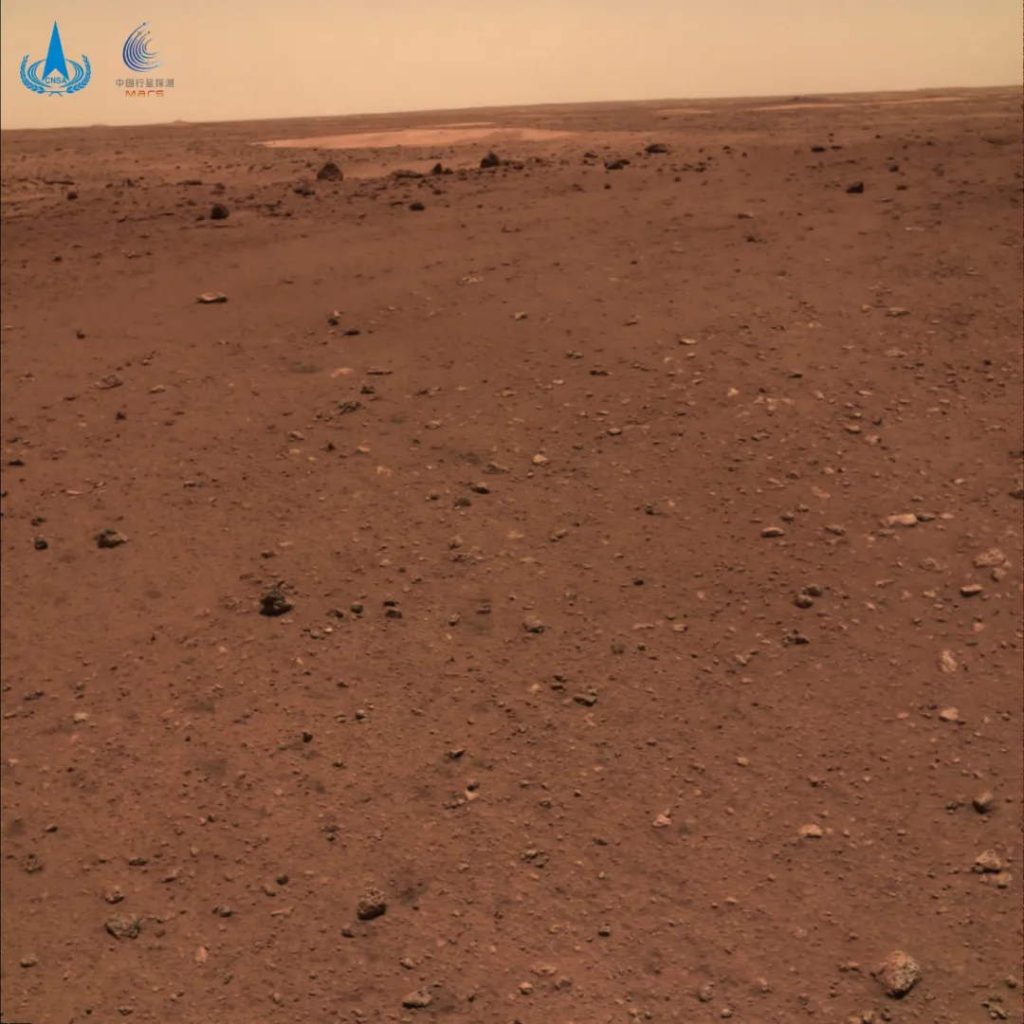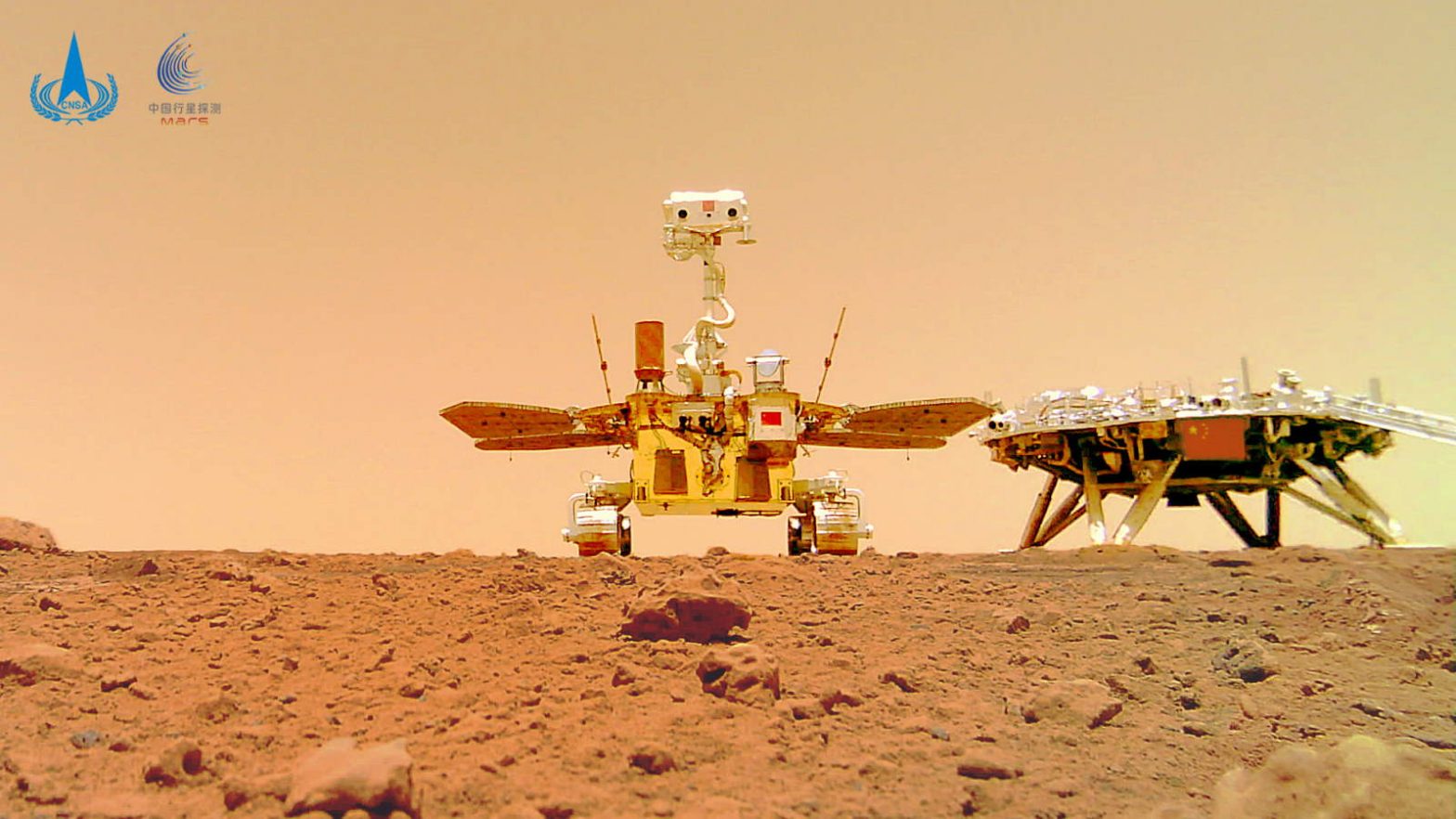Zhurong, the China National Space Administration’s Mars rover sent a historic selfie from the surface of the red planet: the rover went forward, placed a camera on the ground, and went back towards the Tianwen-1 lander for an amazing group photo – quite an effort!
The amazing “touring group photo” from another planet shows the Zhurong rover traveling about 10 meters (33 feet) south of the landing platform, releasing the separate camera installed at the bottom of the vehicle, and then retreating to the vicinity of the landing platform.
The separate camera took pictures of the movement of the Zhurong rover and the photo of the rover and the landing platform. The image is transmitted to the rover through wireless signals and then relayed back to the Earth through the orbiter.

Zhurong and Tianwen-1
Zhurong is named after the god of fire in ancient Chinese mythology, and it is also the Chinese name of Mars – similarly, the common name of the red planet, Mars was the god of war in ancient Roman religion and myth (the Roman equivalent of Ares of the Greek mythology).
Tianwen-1 (Tianwen means “Heavenly Questions”, the title of a poem by the ancient Chinese poet Qu Yuan, circa 340-278 BC) is an interplanetary mission by the China National Space Administration (CNSA) to send a robotic spacecraft to Mars, consisting of 5 spacecraft: an orbiter, deployable camera, lander, a drop-camera (which took the group photo above), and the Zhurong rover.
Zhurong is China’s first rover which landed on another planet.

Related: Curiosity’s new selfie from Mars
Mission Timeline
- The Tianwen-1 mission was launched from the Wenchang Spacecraft Launch Site on 23 July 2020 on a Long March 5 heavy-lift launch vehicle.
- After seven months of transit through the inner solar system, the spacecraft entered Martian orbit on 10 February 2021.
- For the next three months, the probe studied the target landing sites from a reconnaissance orbit.
- On 14 May 2021, the lander/rover portion of the mission successfully touched down on Mars, making China the third nation that managed to land softly on the Martian surface and establish communication from there, after the Soviet Union and the United States.
- On 22 May 2021, the Zhurong rover drove onto the Martian surface via the descent ramps on the landing platform and begun its scientific mission. With the successful deployment of the rover, China became the second nation to accomplish this feat, after the United States, as well as the first nation to orbit, land, and release a rover during its first foray into Martian space.
- In June 2021, The Zhurong rover traveled about 10 meters (33 feet) south of the landing platform, released the separate camera installed at the bottom of the vehicle, and then retreated to the vicinity of the landing platform. The camera took the group photo of both lander and the rover.

The Mars topography map is the first topography and geomorphology image map taken by the navigation terrain camera after the Zhurong rover reaches the surface of Mars. The image shows that the nearby surface is relatively flat, with stones of different sizes distributed, with smooth edges, lighter colors, and semi-buried. There is a ring pit at the far end, with darker, angular stones on the edge of the ring pit, And a few sand dunes farther away.
The mission’s scientific objectives include:
- Investigation of Martian surface geology and internal structure
- Search for indications of the current and past presence of water
- Characterization of the space environment and the atmosphere of Mars.
Scientific Instruments
Orbiter
- Medium-Resolution Camera (MRC) with a resolution of 100 m from a 400 km orbit
- High-Resolution Camera (HRC) with a resolution of 2 m from a 400 km orbit
- Mars Magnetometer (MM)
- Mars Mineralogy Spectrometer (MMS), to determine the elementary composition
- Orbiter Subsurface Radar (OSR)
- Mars Ion and Neutral Particle Analyzer (MINPA)
- Mars Energetic Particle Analyzer
Tianwen-1 Deployable Camera
- Two wide-angle Cameras
Zhurong rover
- Ground-Penetrating Radar (GPR), to image about 100 m (330 ft) below the Martian surface
- Mars Surface Magnetic Field Detector (MSMFD)
- Mars Meteorological Measurement Instrument (MMMI)
- Mars Surface Compound Detector (MSCD), combines laser-induced breakdown spectroscopy (LIBS) and infrared spectroscopy
- Multi-Spectrum Camera (MSC)
- Navigation and Topography Camera (NTC)
Sources
- Tianwen-1 on Wikipedia
- Zhurong (rover) on Wikipedia
- Space Shuttle Endeavour’s Touchdown Meets Columbia’s Salute [An amazing photo from the past] - February 29, 2024
- Moon Landings: All-Time List [1966-2024] - February 23, 2024
- From Orbit to Ordinary: 10 Earthly Applications of Space Technology - January 23, 2024
